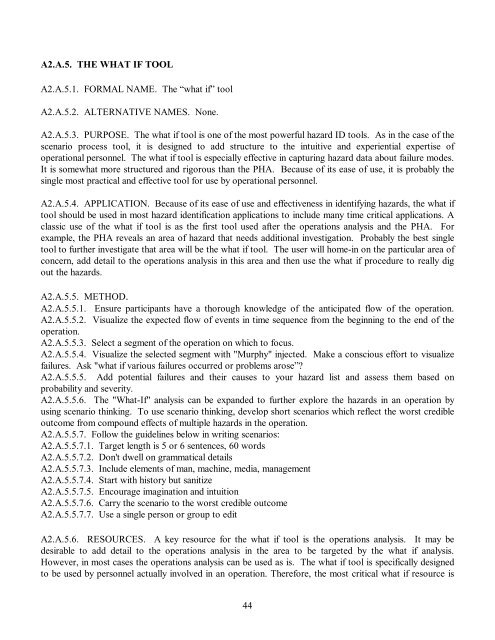BY ORDER OF THE AIR FORCE PAMPHLET 91-215 SECRETARY ...
BY ORDER OF THE AIR FORCE PAMPHLET 91-215 SECRETARY ...
BY ORDER OF THE AIR FORCE PAMPHLET 91-215 SECRETARY ...
You also want an ePaper? Increase the reach of your titles
YUMPU automatically turns print PDFs into web optimized ePapers that Google loves.
A2.A.5. <strong>THE</strong> WHAT IF TOOL<br />
A2.A.5.1. FORMAL NAME. The “what if” tool<br />
A2.A.5.2. ALTERNATIVE NAMES. None.<br />
A2.A.5.3. PURPOSE. The what if tool is one of the most powerful hazard ID tools. As in the case of the<br />
scenario process tool, it is designed to add structure to the intuitive and experiential expertise of<br />
operational personnel. The what if tool is especially effective in capturing hazard data about failure modes.<br />
It is somewhat more structured and rigorous than the PHA. Because of its ease of use, it is probably the<br />
single most practical and effective tool for use by operational personnel.<br />
A2.A.5.4. APPLICATION. Because of its ease of use and effectiveness in identifying hazards, the what if<br />
tool should be used in most hazard identification applications to include many time critical applications. A<br />
classic use of the what if tool is as the first tool used after the operations analysis and the PHA. For<br />
example, the PHA reveals an area of hazard that needs additional investigation. Probably the best single<br />
tool to further investigate that area will be the what if tool. The user will home-in on the particular area of<br />
concern, add detail to the operations analysis in this area and then use the what if procedure to really dig<br />
out the hazards.<br />
A2.A.5.5. METHOD.<br />
A2.A.5.5.1. Ensure participants have a thorough knowledge of the anticipated flow of the operation.<br />
A2.A.5.5.2. Visualize the expected flow of events in time sequence from the beginning to the end of the<br />
operation.<br />
A2.A.5.5.3. Select a segment of the operation on which to focus.<br />
A2.A.5.5.4. Visualize the selected segment with "Murphy" injected. Make a conscious effort to visualize<br />
failures. Ask "what if various failures occurred or problems arose”?<br />
A2.A.5.5.5. Add potential failures and their causes to your hazard list and assess them based on<br />
probability and severity.<br />
A2.A.5.5.6. The "What-If" analysis can be expanded to further explore the hazards in an operation by<br />
using scenario thinking. To use scenario thinking, develop short scenarios which reflect the worst credible<br />
outcome from compound effects of multiple hazards in the operation.<br />
A2.A.5.5.7. Follow the guidelines below in writing scenarios:<br />
A2.A.5.5.7.1. Target length is 5 or 6 sentences, 60 words<br />
A2.A.5.5.7.2. Don't dwell on grammatical details<br />
A2.A.5.5.7.3. Include elements of man, machine, media, management<br />
A2.A.5.5.7.4. Start with history but sanitize<br />
A2.A.5.5.7.5. Encourage imagination and intuition<br />
A2.A.5.5.7.6. Carry the scenario to the worst credible outcome<br />
A2.A.5.5.7.7. Use a single person or group to edit<br />
A2.A.5.6. RESOURCES. A key resource for the what if tool is the operations analysis. It may be<br />
desirable to add detail to the operations analysis in the area to be targeted by the what if analysis.<br />
However, in most cases the operations analysis can be used as is. The what if tool is specifically designed<br />
to be used by personnel actually involved in an operation. Therefore, the most critical what if resource is<br />
44
















